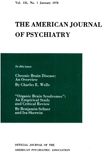Screen Memories in a Pair of Monozygotic Twins Discordant for Involutional Depression and Psychophysiological Disorders
Abstract
The authors studied a pair of monozygotic twins who became discordant for mental and physical disorders late in life. Differences in the twins' early histories, earliest memories, and reactions to the loss of their mother when they were children suggest that their early interactions with their environment resulted in different modes of adaptation, which subsequently became internalized as different defensive and characterological patterns. The authors believe that the specific environmentally determined psychodynamic influences described in the paper serve to explain the twins' discordance for disease.
Access content
To read the fulltext, please use one of the options below to sign in or purchase access.- Personal login
- Institutional Login
- Sign in via OpenAthens
- Register for access
-
Please login/register if you wish to pair your device and check access availability.
Not a subscriber?
PsychiatryOnline subscription options offer access to the DSM-5 library, books, journals, CME, and patient resources. This all-in-one virtual library provides psychiatrists and mental health professionals with key resources for diagnosis, treatment, research, and professional development.
Need more help? PsychiatryOnline Customer Service may be reached by emailing [email protected] or by calling 800-368-5777 (in the U.S.) or 703-907-7322 (outside the U.S.).



